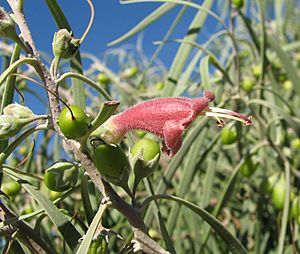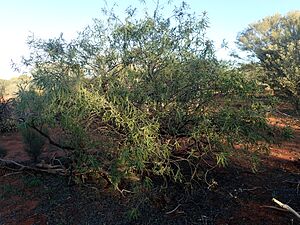Berrigan facts for kids
Quick facts for kids Berrigan |
|
|---|---|
 |
|
| Eremophila longifolia in Royal Botanic Gardens, Cranbourne | |
| Scientific classification | |
| Genus: |
Eremophila (plant)
|
| Species: |
longifolia
|
| Synonyms | |
The Berrigan (scientific name: Eremophila longifolia) is a special flowering plant found only in Australia. It belongs to the figwort family. This plant can be a shrub or a small tree. It has branches that droop, long thin leaves, and pretty brick-red or pink flowers. You can find Berrigan plants in all mainland Australian states and the Northern Territory.
Contents
What Does Berrigan Look Like?
The Berrigan plant can grow from about 1 to 8 meters (3 to 26 feet) tall. It often grows in thick groups because new plants can sprout from its roots. These new plants are like copies of the original one.
Its branches often have fine, yellowish to reddish-brown hairs. The leaves grow one after another along the branches. They are long and narrow, sometimes curved like a sickle, and often have a hooked tip. Most leaves are about 50-160 mm (2-6 inches) long and 3-8 mm (0.1-0.3 inches) wide. They get narrower at both ends and have a clear line down the middle on the underside.
Berrigan Flowers and Fruits
The flowers grow in groups of up to five where the leaves meet the stem. Each flower has a short stalk, usually 4-8 mm (0.1-0.3 inches) long. There are five green, egg-shaped, hairy parts called sepals at the base of the flower.
The petals are usually 20-30 mm (0.8-1.2 inches) long. They join together at the bottom to form a tube. This tube is brick-red to pink, and sometimes has darker red spots inside. Both the inside and outside of the tube are covered with hairs. Four stamens (the parts that hold pollen) stick out beyond the end of the petal tube.
Berrigan plants can flower at different times of the year, depending on where they are and how much rain they get. In some areas, they flower mainly in spring and summer. In others, they can flower in any season. After flowering, the plant produces oval or round fruits. These fruits are 5-12 mm (0.2-0.5 inches) long. They start yellow, then turn brown, and finally become black.

How Berrigan Got Its Name
The first scientific description of this plant was written in 1810 by Robert Brown. He called it Stenochilus longifolius. Later, in 1860, Ferdinand von Mueller changed the name to Eremophila longifolia.
The name longifolia comes from two Latin words: longus, meaning "long," and folium, meaning "leaf." This describes the plant's long leaves.
Other Names for Berrigan
Besides Berrigan, this plant has many other common names. These include berregan emu bush, long-leaved emu bush, weeping emu bush, native plum, juniper tree, and dogwood. Some of these names are also used for other plants, which can be a bit confusing!
Aboriginal people have their own names for this plant. For example, the Anmatjirra people call it amuna. The Pitjantjatjara people call it tulypurpa.
Where Does Berrigan Grow?
The Berrigan is the most common type of Eremophila plant in Australia. This is because it can grow in many different types of soil and places. It can be found almost everywhere except the very wet areas of the east coast. You will often see it in woodlands with Acacia or Eucalyptus trees. It also grows well on rocky hills, sandy plains, and sand dunes.
Who Eats Berrigan?
Many animals use the Berrigan plant as a food source. Honeyeater birds enjoy its flowers. Emus and Australian bustards also feed on parts of the plant.
Is Berrigan Endangered?
The Western Australian Government's Department of Parks and Wildlife says that the Berrigan species is "not threatened." This means it is not currently in danger of disappearing.
How People Use Berrigan
Traditional Aboriginal Uses
The Berrigan plant is very important to Aboriginal people, especially those in Central Australia. They have many traditional uses for it. It was used in special ceremonies and to prepare graves. People also used it to make water bags and for headbands worn by warriors.
Berrigan also had medicinal uses. It was used to treat colds and headaches. It was also used to help cleanse and strengthen new-born babies.
Berrigan in Farming
Berrigan is considered one of the best Eremophila species for feeding sheep and cattle. Farmers sometimes use it to feed their animals during dry times when other food is scarce. However, it can be harmful if animals eat too much of it without other food.
The plant can also act as a natural windbreak, protecting fields from strong winds. Its strong root system helps to prevent soil from being washed away by rain or blown away by wind.
Berrigan in Gardens
Even though Berrigan is a tough plant with pretty flowers and drooping branches, it is not very well known in gardening. It could make a good informal hedge.
It can be tricky to grow Berrigan from seeds. Cuttings (pieces of the plant) often do not grow roots easily. However, the new plants that sprout from the roots (suckers) can be easily moved and replanted. If you don't want the plant to spread by suckers, or if you have heavy soil, you can grow it by grafting it onto a Myoporum plant's roots.
Berrigan in Medicine
Scientists have found that Berrigan plants contain special compounds. These compounds have been shown to help control bacteria that cause tooth decay.
Images for kids
-
Eremophila longifolia in Royal Botanic Gardens, Cranbourne
-
E. longifolia growing at Karalundi





